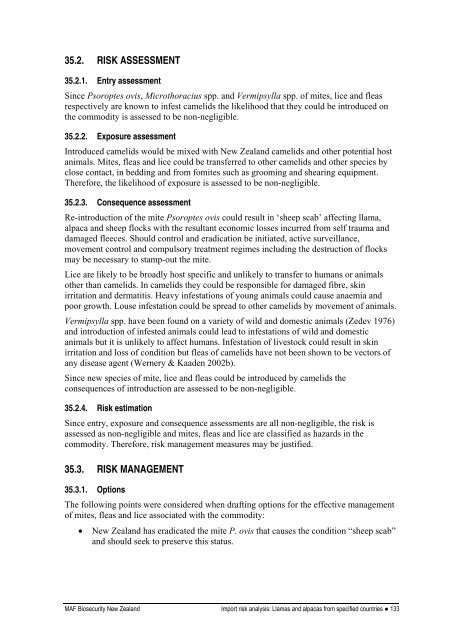Import risk analysis: Llamas (Lama glama) and alpacas (Vicugna ...
Import risk analysis: Llamas (Lama glama) and alpacas (Vicugna ...
Import risk analysis: Llamas (Lama glama) and alpacas (Vicugna ...
You also want an ePaper? Increase the reach of your titles
YUMPU automatically turns print PDFs into web optimized ePapers that Google loves.
35.2. RISK ASSESSMENT<br />
35.2.1. Entry assessment<br />
Since Psoroptes ovis, Microthoracius spp. <strong>and</strong> Vermipsylla spp. of mites, lice <strong>and</strong> fleas<br />
respectively are known to infest camelids the likelihood that they could be introduced on<br />
the commodity is assessed to be non-negligible.<br />
35.2.2. Exposure assessment<br />
Introduced camelids would be mixed with New Zeal<strong>and</strong> camelids <strong>and</strong> other potential host<br />
animals. Mites, fleas <strong>and</strong> lice could be transferred to other camelids <strong>and</strong> other species by<br />
close contact, in bedding <strong>and</strong> from fomites such as grooming <strong>and</strong> shearing equipment.<br />
Therefore, the likelihood of exposure is assessed to be non-negligible.<br />
35.2.3. Consequence assessment<br />
Re-introduction of the mite Psoroptes ovis could result in ‘sheep scab’ affecting llama,<br />
alpaca <strong>and</strong> sheep flocks with the resultant economic losses incurred from self trauma <strong>and</strong><br />
damaged fleeces. Should control <strong>and</strong> eradication be initiated, active surveillance,<br />
movement control <strong>and</strong> compulsory treatment regimes including the destruction of flocks<br />
may be necessary to stamp-out the mite.<br />
Lice are likely to be broadly host specific <strong>and</strong> unlikely to transfer to humans or animals<br />
other than camelids. In camelids they could be responsible for damaged fibre, skin<br />
irritation <strong>and</strong> dermatitis. Heavy infestations of young animals could cause anaemia <strong>and</strong><br />
poor growth. Louse infestation could be spread to other camelids by movement of animals.<br />
Vermipsylla spp. have been found on a variety of wild <strong>and</strong> domestic animals (Zedev 1976)<br />
<strong>and</strong> introduction of infested animals could lead to infestations of wild <strong>and</strong> domestic<br />
animals but it is unlikely to affect humans. Infestation of livestock could result in skin<br />
irritation <strong>and</strong> loss of condition but fleas of camelids have not been shown to be vectors of<br />
any disease agent (Wernery & Kaaden 2002b).<br />
Since new species of mite, lice <strong>and</strong> fleas could be introduced by camelids the<br />
consequences of introduction are assessed to be non-negligible.<br />
35.2.4. Risk estimation<br />
Since entry, exposure <strong>and</strong> consequence assessments are all non-negligible, the <strong>risk</strong> is<br />
assessed as non-negligible <strong>and</strong> mites, fleas <strong>and</strong> lice are classified as hazards in the<br />
commodity. Therefore, <strong>risk</strong> management measures may be justified.<br />
35.3. RISK MANAGEMENT<br />
35.3.1. Options<br />
The following points were considered when drafting options for the effective management<br />
of mites, fleas <strong>and</strong> lice associated with the commodity:<br />
� New Zeal<strong>and</strong> has eradicated the mite P. ovis that causes the condition “sheep scab”<br />
<strong>and</strong> should seek to preserve this status.<br />
MAF Biosecurity New Zeal<strong>and</strong> <strong>Import</strong> <strong>risk</strong> <strong>analysis</strong>: <strong>Llamas</strong> <strong>and</strong> <strong>alpacas</strong> from specified countries ● 133

















